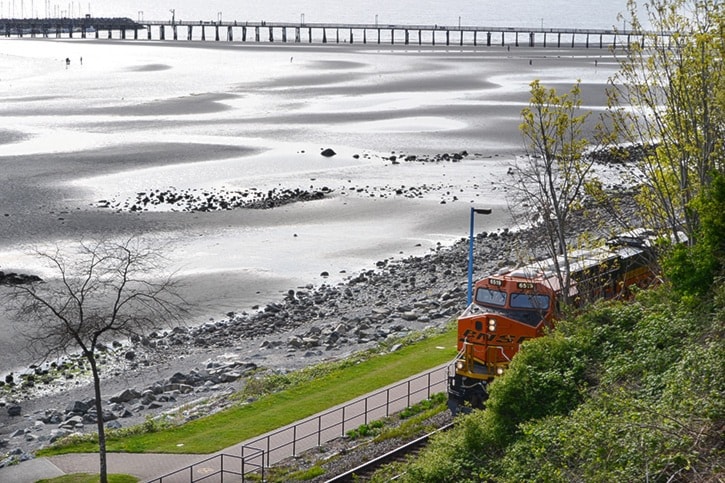In a critical letter to Minister of Transport Lisa Raitt, White Rock officials say hauling dangerous goods by rail through their “densely populated” city is unacceptable.
And they all but demand steps be taken to re-route such trains 30 kilometres east to a BNSF rail line that runs to and from the U.S. at Sumas Crossing in Abbotsford.
In the letter dated April 8 – and received by Peace Arch News Tuesday – White Rock Mayor Wayne Baldwin and Couns. Grant Meyer and Al Campbell say their small seaside community is too populated to transport noxious goods, from crude oil to chlorine, several times a day through the area.
A dangerous-goods derailment “would be calamitous – making the Lac Mégantic incident look inconsequential by comparison,” the letter states, referring to the July 2013 explosion in Quebec that killed 47 people.
“Madame Minister, in light of the circumstances we have outlined, I cannot stress enough how important this situation is with the dangerous goods,” the politicians write. “It really is not a question of if a derailment occurs, it is a question of when it occurs.”
Sending the missive to Raitt was recommended by the city’s new rail-safety task force last month. The idea received unanimous support from council March 31.
While the letter specifies a ‘spur line’ in Sumas, it suggests there are other options.
“The City of White Rock would like to see all dangerous goods re-routed to the Sumas Crossing, or some other route available to the BNSFR,” the letter states.
Informed Wednesday of White Rock’s letter, an Abbotsford councillor said re-routing dangerous goods through his community would be “shifting a problem to a different jurisdiction.”
Coun. Henry Braun, former president of railroad-contractor PNR RailWorks, said that though Abbotsford has a lower population density than White Rock, the potential impact of an incident on farmland is of great concern.
He noted the population of the Fraser Valley is expected to greatly increase in coming years.
While Braun said he is not against transporting dangerous goods – as the economy relies on it – he said the federal government and railroad companies should find ways to address railway safety for all communities through more stringent regulations and better equipment.
Meyer, who chairs White Rock’s task force, told PAN his city’s direct approach was intentional.
“The letter makes strong points to… get this conversation started in a serious manner,” he said.
The letter notes: “One might ask why would White Rock and South Surrey merit special concern for the transport of dangerous goods.”
It suggests that in addition to general density, the waterfront is particularly busy during the summer; the beaches have “the absolute highest environmental rating”; and a derailment in the bluff area between White Rock and South Surrey’s Crescent Beach would provide no evacuation route for Crescent Beach.
Other points cited include slope instability; a UBC study that concludes vibrations from passing trains exceed recommended guidelines; and concerns with the condition of the rail bridge over Little Campbell River.
The letter states that despite those concerns being raised to Transport Canada shortly after the Lac-Mégantic derailment, they have yet to be addressed.
“The bridge remains in a shocking state of disrepair and the train traffic is not only unabated, it is increasing and the loads are getting heavier.”
(BNSF officials say plans to replace the bridge have been stymied by negotiations with Semiahmoo First Nation for access rights to the property.)
The city’s letter is critical of the apparent inaction to date.
“It is totally unacceptable that a railroad carrying dangerous goods through one of the most densely populated municipalities in B.C., along the most ecologically sensitive shoreline in the province, could allow its infrastructure to decay to such a shocking state.”
The bridge “is so rusted out that one can literally punch a hole in the web of the cross member I-beams with their fingers.”
Meyer said the bridge is among issues he will discuss at a meeting with BNSF officials next week in Seattle. Safety of rail crossings, extend White Rock’s promenade and the hope of a caboose for the waterfront are also on the list.
Meyer noted that while the letter comes across as critical of BNSF’s inaction on the rail bridge and limited co-operation when it comes to sharing details of train cargo, it is not intended as an attack on the company or railway.
It requests a meeting with Raitt, which Baldwin hopes can occur during next month’s Federation of Canadian Municipalities conference in Niagara Falls.
The idea of relocating the line was discussed at a community forum hosted by the City of Surrey in December. At that time, Surrey Mayor Dianne Watts presented four options for realigning the BNSF tracks, with three of the routes just east of 176 Street. Some attendees were not pleased at the suggestion to move the problem from one community to another.
Meyer acknowledged no one solution will eliminate all risk, nor will it please everyone.
"If you can get dangerous goods in general going through a rural or sparsely populated area, that's got to be better," he said.
"There's ways to make things safer and take some of the risk out."
– with files from Alex Butler
